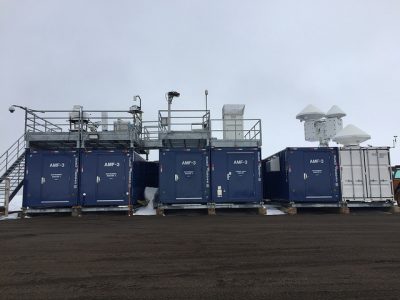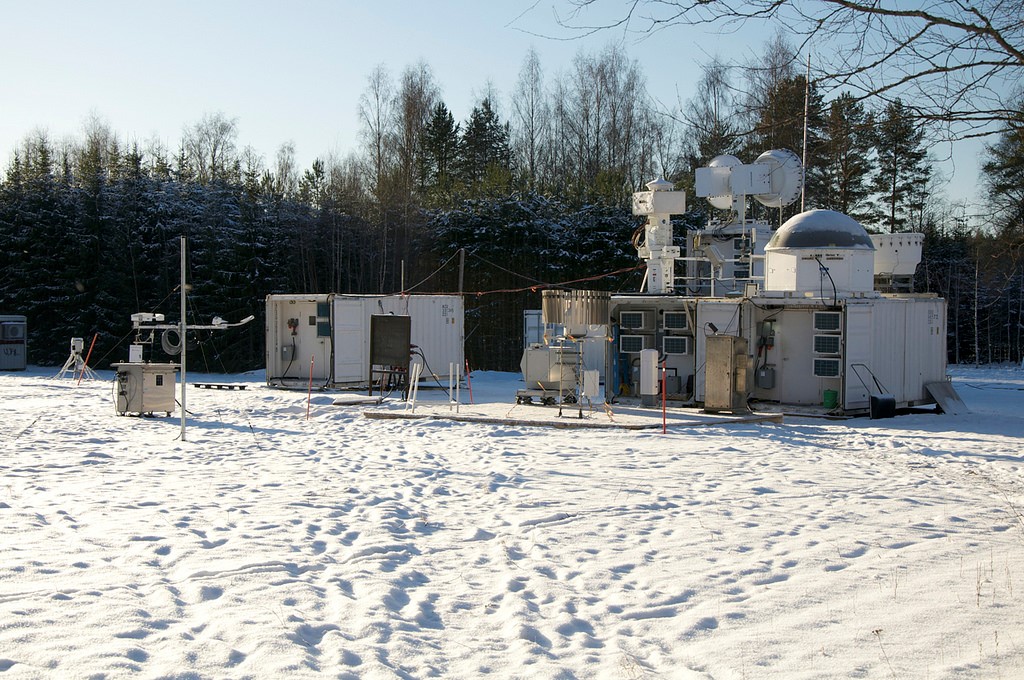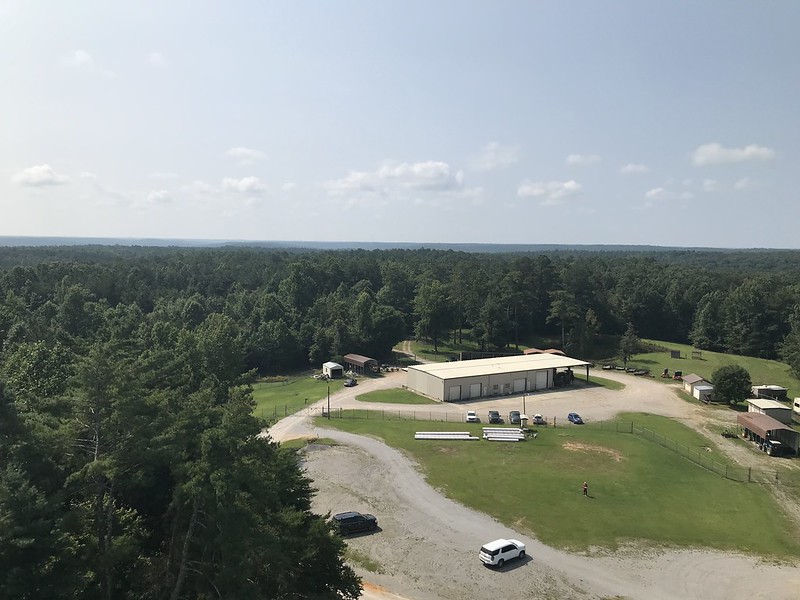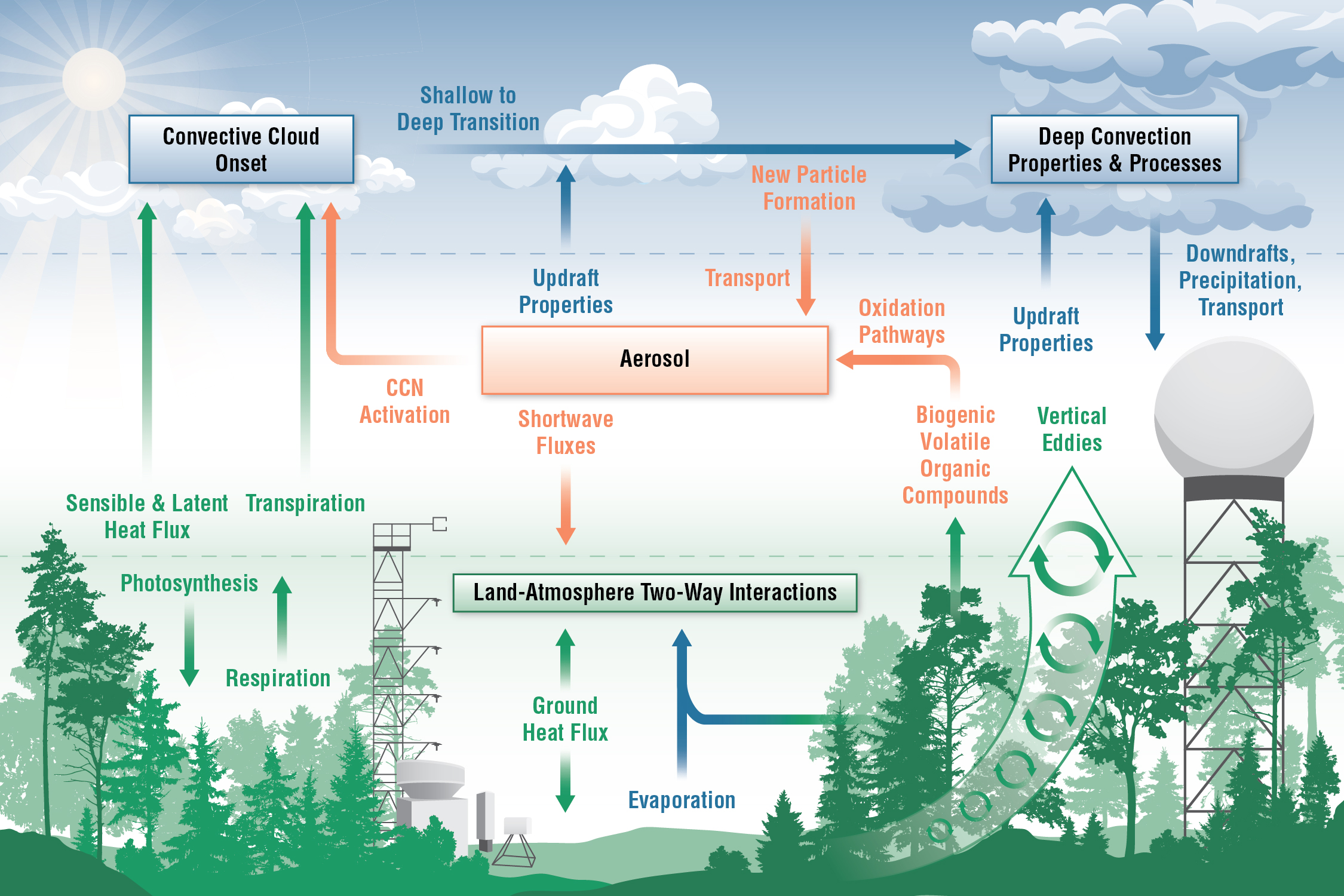ARM Prepares to Move Into Bankhead National Forest
Published: 23 March 2023
Construction of new atmospheric observatory underway in Alabama; main site expected to start operating in current fiscal year
The main site of the Atmospheric Radiation Measurement (ARM) user facility’s newest atmospheric observatory is beginning to take shape.
ARM met a crucial February 2023 deadline to clear trees for the instruments and containers that will form the core of the Bankhead National Forest (BNF) observatory in northwestern Alabama. This means that the BNF remains on track to begin operations in fiscal year 2023 as planned.
Most of the instruments will be located in a 300-by-300-foot clearing immediately south of the U.S. Forest Service’s Black Warrior Work Center (BWWC). The Forest Service uses the BWWC for regular maintenance activities. In addition, ARM will have an office just north of the BWWC.

In cooperation with the Forest Service, ARM will also make site improvements and reconfigure a part of the site layout to accommodate the new facility.
To address the land-atmosphere science goals of the deployment, a 140-foot instrument tower will be located in mixed pine-oak forest that is representative of the larger Bankhead. The tower will stand about three-quarters of a mile west of the BWWC.
ARM anticipates two more installation phases for the expected five-year deployment.
Road to the Bankhead

The tree clearing represents an important milestone in the journey of the third ARM Mobile Facility (AMF3).
In 2019, ARM announced it would end AMF3 operations at Oliktok Point, Alaska, and move the mobile facility to the Southeastern United States. The Southeast emerged as a region of interest for further study during a 2018 mobile facility workshop.
The U.S. Department of Energy (DOE) put out a call for a national laboratory-led team to create the science plan and initial research project for the new AMF3 deployment.
A multi-institutional team led by Chongai Kuang, an aerosol scientist at Brookhaven National Laboratory in New York, submitted the chosen proposal.
The AMF3 site science team, funded by ARM and DOE’s Atmospheric System Research (ASR) program, seeks to improve process understanding and model representation of aerosol, cloud, and land-atmosphere interactions.
In June 2021, AMF3 stopped collecting data at Oliktok Point after almost eight years of operations overseen by Sandia National Laboratories in New Mexico.
While ARM packed up AMF3 in Alaska, the AMF3 site science and operations teams kept working to determine the optimal placement of the mobile facility in the Southeastern United States.
During the 2021 American Geophysical Union Fall Meeting, Kuang announced an area near the BWWC as the leading candidate for the main site, based on science-driven criteria developed and applied by the site science team. The main site will be close to that location.
Sandia, with support from the site science team, initiated discussions with the Forest Service regarding the area around the BWWC as a possible location before handing off management of the AMF3 Southeastern U.S. deployment to Argonne National Laboratory in Illinois.
Argonne also oversees ARM’s Southern Great Plains (SGP) atmospheric observatory, while Sandia still manages the North Slope of Alaska (NSA) observatory.
ARM/Argonne submitted a special use permit to the Forest Service for the AMF3 site that was approved in December 2022.
Forest Service staff have been accommodating partners during the BNF siting process, says ARM Associate Director for Operations Nicki Hickmon.
“They are definitely great collaborators when it comes to understanding the science that could be done there atmospherically, ecologically, microbially,” says Hickmon. “They’re amazing resources.”
The Forest Service has also helped identify research partners in the area.
Anticipating Forest Challenges

The AMF3 site science team has been working diligently to make sure that “we have the right observational resources in the right places so we can actually measure what we need to measure,” says Kuang.
It helps that members of the site operations team have previously deployed ARM instruments within a forest.
In 2014, ARM sent a mobile facility to a Scots pine forest in Finland for the Biogenic Aerosols – Effects on Clouds and Climate (BAECC) field campaign. Hickmon and Argonne colleague Mike Ritsche helped set up instruments for BAECC. Ritsche is now the AMF3 manager.
Other members of the site operations team include Patty Campbell and Mark Spychala, who both recently joined ARM.
While knowledge gained from BAECC has been useful in planning for the BNF, every ARM deployment presents unique challenges.
In Alabama, ARM already met one challenge: avoiding the Bankhead’s bat population.
To achieve its goal of starting BNF operations in fiscal year 2023, ARM had to clear trees between December 1, 2022, and February 28, 2023, when the Forest Service did not expect bats to be present. ARM finished with six days to spare.

Whereas BAECC took place at an established forestry research station with its own instruments, the site science and operations teams are “starting from scratch” at the BNF, says Hickmon. The teams are sorting out how to set up the 140-foot tower and work more within the forest.
“We’re trying to get more at what’s happening in the forest whereas a lot of the other measurements we’ve done for ARM were just trying to figure out radiation at the top of the forest,” says Ritsche. “Now we’re trying to figure out what’s filtered through all the way to the bottom, including aerosol.”
‘Going Above and Beyond’
While ARM primes the BNF’s main site for construction, instruments and containers for the new deployment are being prepared at the SGP.
Stretching across north-central Oklahoma and southern Kansas, the SGP is ARM’s largest and oldest observatory, having collected atmospheric data since 1992.
This is the first time ARM is using the SGP to stage and prepare a mobile facility. While performing their regular site duties, SGP staff, including engineer Kent Stehno, have been busy with AMF3 work.
“They’re really going above and beyond, and we’re very, very grateful that they are the hub,” says Hickmon. “They’re the biggest site we have, and they have been the hub for a long time, but what being the hub means varies over the years, and they’ve really stepped up.”
Timeline of BNF Phases

ARM expects the BNF’s main instruments, office, and tower to be operational in fiscal year 2023.
New for a mobile facility deployment, ARM is preparing to have a Guest Instrument Facility and a dedicated space for guest aerosol instruments at the main site.
Connecting the guest aerosol instrument space to ARM’s Aerosol Observing System (AOS) will allow for easier intercomparison of measurements, says Kuang. The guest aerosol space will have an inlet similar to that of the AOS.
For the protection of those onsite during extreme weather events, ARM plans to add two tornado shelters.
In fiscal year 2024, ARM intends to set up supplemental sites in the spring.
The third and final installation phase, which would include instruments and tasks left from the first two phases, is set for fiscal year 2025.
View the latest BNF instrument plan.
Proposing a BNF Campaign
ARM expects to start supporting guest instruments at the BNF no earlier than spring 2024.
Some activities proposed by the research community will likely require special use permits from the Forest Service, so scientists interested in submitting a field campaign proposal should propose early and plan on additional time for reviews.
Science Planning and Collaborations
The AMF3 site science team is working on a science plan that will soon appear on the ARM website. As with all AMF deployments, the plan will describe the high-level science goals of the deployment and how the AMF3 sampling and analysis infrastructure will help meet those goals.
However, the AMF science plan is just the start of the science that can be done with the planned measurements.
Like all ARM sites, the BNF will be open to the user community to propose additional guest instrument deployments and to use the data in their own research projects and proposals. For example, DOE’s ASR recently released a call to fund new science projects, including the study of Southeastern U.S. atmospheric processes through the early use of AMF3 data.
The AMF3 site science team is preparing to implement its science plan as soon as data start flowing.
“We have a dedicated, approved project space to leverage ARM high-performance computing to start setting up high-resolution models so that once we do get observations, we are ready for the analysis,” says Kuang. “This space will also be used for data collection and processing.”
Already, BNF collaborations are in the works with the University of Alabama in Huntsville and field measurement networks such as AmeriFlux and the Alabama MesoNet.
In recent years, the DOE Office of Science has provided an increased number of funding and research opportunities for historically underrepresented groups in STEM by targeting opportunities for Historically Black Colleges and Universities (HBCUs), Minority-Serving Institutions, and emerging research institutions.
The AMF3 site science team has taken its own steps to reach out to these groups. One promising relationship has formed with Alabama A&M University, which lays claim to the only professionally accredited forestry program at an HBCU.
Within DOE, the site science team is engaging with members of the ARM, ASR, and Environmental System Science (ESS) communities to provide information about the upcoming deployment.
The Southeastern U.S. deployment was the topic of a breakout session during the hybrid Joint ARM User Facility/ASR Principal Investigators Meeting in October 2022.
Right before the joint meeting, Kuang presented on the new deployment during a virtual workshop co-hosted by ARM and another DOE Office of Science user facility, the Environmental Molecular Sciences Laboratory (EMSL), which helps to support ESS research. This workshop brought together ARM and EMSL staff and users, ASR scientists, and ESS researchers. Participants discussed ideas and opportunities to improve understanding of coupled land-atmosphere processes.
The workshop informed a recent joint call to integrate ARM and EMSL capabilities. This call sought proposals to examine aerosol processes, aerosol-cloud interactions, or land-atmosphere processes with the aim of improving earth system models. As part of the call, scientists could propose tethered balloon system missions at the SGP, NSA, or BNF to collect aerosol samples for analysis at EMSL in fiscal year 2024.
In addition, the site science team has connected with Science Focus Area projects supported by ASR and ESS.

Spring/Summer 2023 Workshops
More opportunities for cross-community engagement are coming in the next few months.
From April 10 to 13, Shawn Serbin, the AMF3 site science team’s topical area lead for land-atmosphere interactions, will join ARM Director Jim Mather and more than 30 other researchers at the Global Energy and Water Exchanges (GEWEX) Integrated Product Workshop in Toledo, Spain. Serbin is an associate scientist within Brookhaven Lab’s Terrestrial Ecosystem Science and Technology Group.
The GEWEX workshop theme is “Exploring the Relationship Between Land Surface Fluxes and Our Ability to Close the Water Budget.” Mather, a co-organizer of the workshop, will present on ARM activities supporting land-atmosphere interaction research.
On June 20 and 21, the site science team will gather for a workshop at Brookhaven Lab. Because of COVID, it will be the team’s first in-person meeting.
More information about the BNF will be provided at the 2023 Joint ARM User Facility/ASR Principal Investigators Meeting from August 7 to 10 in Rockville, Maryland.
After that, it won’t be long before the BNF is expected to start gathering data.
Keep up with the Atmospheric Observer
Updates on ARM news, events, and opportunities delivered to your inbox
ARM User Profile
ARM welcomes users from all institutions and nations. A free ARM user account is needed to access ARM data.


















